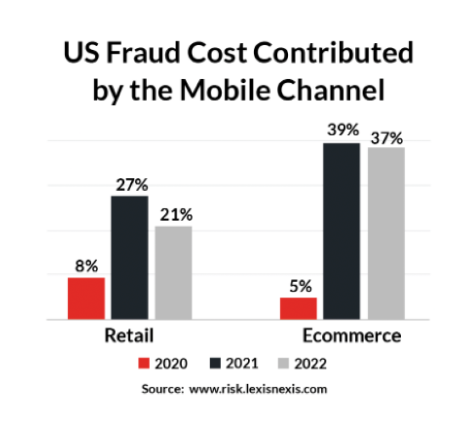Mobile wallet usage has grown so rapidly since Google first marketed Google Wallet in 2011. Today, major banks are teaming up to challenge Google and other big players like Apple with their own digital wallets later this year.
But new payment technology, coupled with widespread usage, always means that fraudsters will find a way to exploit it, and mobile wallets are a prime target.
According to LexisNexis, fraud contributed by the mobile channel in both the U.S and Canada accounts for a sizeable portion of fraud costs.

Here are a some of the most common ways that these creative criminals are taking advantage of mobile payment platforms.
Accidental payment scams
Particularly common in payment apps like Venmo, PayPal, and Zelle, fraudsters deceive customers into “refunding” them money by claiming to have accidentally sent them funds through their digital wallet.
Impersonating customer support
A form of account takeover fraud in which criminals pose as bank employees and send customers fraudulent links via email or text message to obtain their digital wallet information.
Impersonating a friend or family member in need
Fraudsters may impersonate a customer’s friend or family member and request money urgently, hoping that the customer will act without verifying their identity.
Debt scams
Scammers may claim that the target has an outstanding debt and demand immediate payment to avoid legal or other consequences. This tactic aims to pressure customers into making hasty transactions without confirming the legitimacy of the request.
Tips for Combating Mobile Wallet Fraud
Here are some steps banks and credit unions can take to help prevent and combat mobile wallet fraud efficiently:
Analyze User Behavior Patterns: By analyzing behavioral patterns and transaction history, banks and credit unions can identify unusual activities and flag them for further investigation. This can help prevent fraud before it occurs.
Use Machine Learning to Predict Fraud Patterns: Machine learning algorithms can help banks and credit unions predict fraud patterns in digital wallet transactions, enabling them to take proactive measures to prevent fraud. By detecting fraud patterns early, banks and credit unions can reduce losses and protect their customers’ assets.
Employ Card Fingerprinting: Card fingerprinting provides a way to correlate multiple tokens that contain the same data without needing access to the underlying data. This can help banks and credit unions identify fraudulent activities and prevent them from occurring.
Verify and Authenticate New Cards Individually: By verifying and authenticating new cards added to a mobile wallet individually, banks and credit unions can prevent fraudsters from adding stolen or fake cards to a wallet. This can help ensure that only legitimate cards are added to the mobile wallet.
Work Closely with Mobile Wallet Providers: By collaborating with mobile wallet providers, banks and credit unions can share information and develop more effective fraud prevention strategies. This can help ensure that fraud prevention efforts are coordinated and effective across the entire mobile wallet ecosystem.
Real-time Fraud Detection: Banks and credit unions can use real-time fraud detection tools to monitor mobile wallet transactions and identify suspicious activity. These tools encompass a range of features such as transaction monitoring, real-time risk analytics, geo-location tracking, and instant fraud alerts. By leveraging these tools, financial institutions can promptly detect fraudulent behavior as it occurs, allowing them to take immediate action and mitigate potential losses.
Regular Security Training: Banks and credit unions should provide regular security training to their employees and customers to ensure they are aware of the latest threats and how to avoid them. This can help ensure that everyone involved in mobile wallet transactions is knowledgeable and vigilant about fraud prevention.
Customer Education: Banks and credit unions should also educate their customers on how to use mobile wallets securely. This education can include information on how to protect their mobile device, how to avoid phishing scams, and how to monitor their accounts for suspicious activity.
Regular Security Audits: Regular security audits can help banks and credit unions identify vulnerabilities in their mobile wallet systems and address them before they can be exploited by fraudsters. This can help ensure that the mobile wallet ecosystem remains secure and resilient to fraud.
Getting the Jump on Fraudsters
The popularity of mobile wallets has made them an attractive target for fraudsters, so banking professionals involved in fraud prevention will always be engaged in a game of card fraud whack-a-mole. Financial institutions can take steps to prevent and detect mobile wallet fraud before it gets out of hand. For more information on mobile wallet fraud and prevention, download our latest ebook, “Mobile Wallets: Fraud’s New Frontier.”
